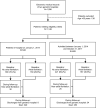Epidemiology, risk profile, management, and outcome in geriatric patients with atrial fibrillation in two long-term care hospitals
- PMID: 36333439
- PMCID: PMC9636160
- DOI: 10.1038/s41598-022-22013-6
Epidemiology, risk profile, management, and outcome in geriatric patients with atrial fibrillation in two long-term care hospitals
Abstract
Aim of this study was investigate the prevalence and incidence of atrial fibrillation (AF) and to describe the clinical characteristics, risk profiles, and types of anticoagulant therapy for stroke prevention and the clinical outcomes in persons admitted to a long-term care hospital. We conducted a retrospective cohort study using data from the electronic medical records of patients aged 65 years or older living in two long-term care hospitals between January 1, 2014 and October 31, 2017. Overall data from 1148 patients (mean age 84.1 ± 7.9 years, 74.2% women) were analyzed. At baseline, the median CHA2DS2-VASc score was 4 (IQR 3-5) and the HAS-BLED score 2 (IQR 2-3). We observed patients over a median period of 3.7 years. The point prevalence of AF was 29.6% (95% CI 25.8-33.7) on January 1, 2014. The 1-year cumulative incidence of de novo AF was 4.0% (2.8-5.6). Oral anticoagulants were prescribed in 48% of patients with AF. The cumulative incidence at 1 year for a composite outcome of TIA, stroke, or systemic arterial embolism was 0.6% (0.1-3.1) and 1.7% (0.5-4.6) and for bleeding 2.6% (0.9-6.2) and 1.8% (0.5-4.8) in patients with AF and oral anticoagulants or no oral anticoagulants, respectively. In long-term care hospital patients, we observed a high burden of AF. However, only about half of patients with AF received oral anticoagulation for stroke prevention.
© 2022. The Author(s).
Conflict of interest statement
CG, GG, DM, SN, GO, and GW have no conflicts of interest. CA received honoraria for lectures and participation in advisory boards from Bayer, BMS/Pfizer, and Daiichi-Sankyo. IP received honoraria for lectures and participation in advisory boards from Bayer, Pfizer, and Daiichi-Sankyo. MS received honoraria from Eli Lilly, Novartis, Pfizer, Amgen, Sanofi-Aventis, Roche, and Boehringer.
Figures
References
Publication types
MeSH terms
Substances
LinkOut - more resources
Full Text Sources
Medical



